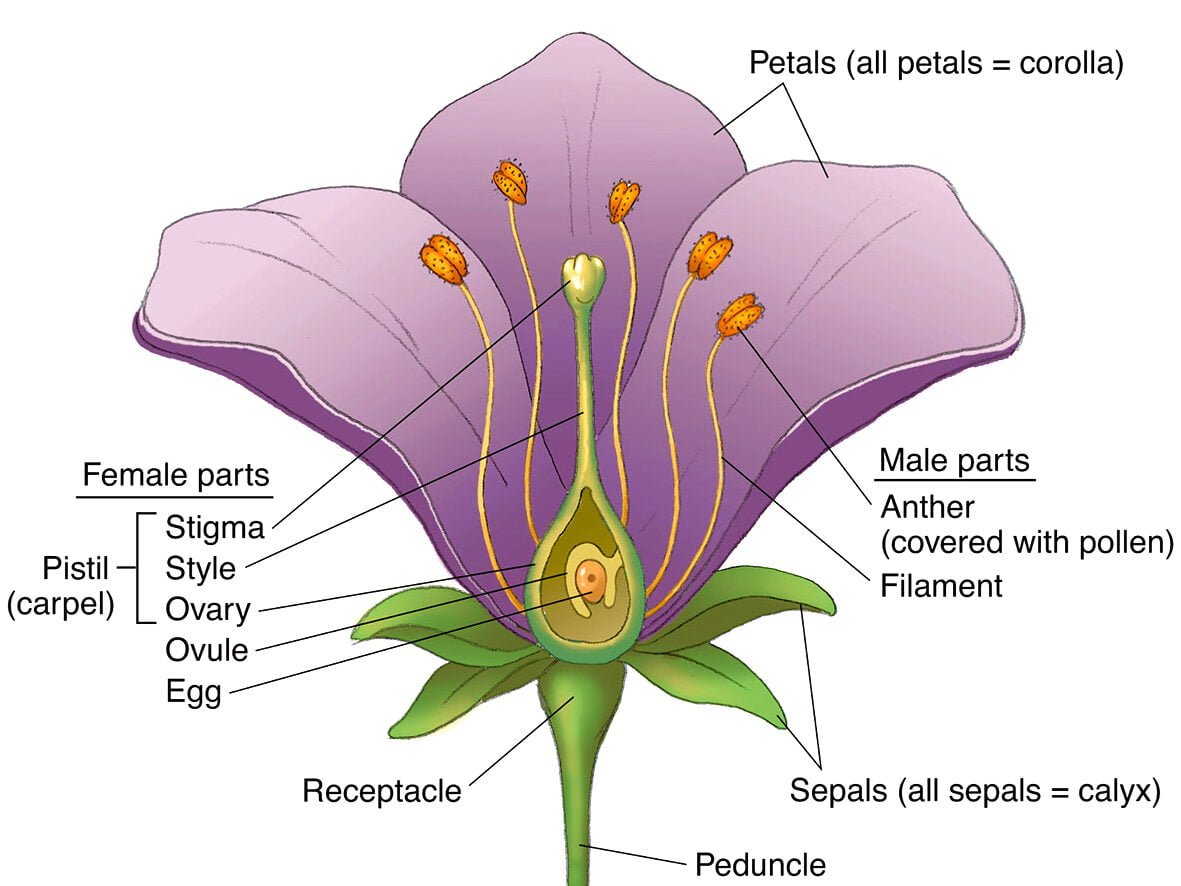Sexual reproduction in flowering plants neet questions
Complete NEET Question Bank with Detailed Solutions
Introduction
Sexual reproduction in flowering plants involves the transfer of pollen from anther to stigma, leading to fertilization and seed formation. This process is crucial for NEET as it carries ~5-8% weightage in the Biology section.
NEET Focus Areas:
- Structure of flower and reproductive parts
- Pollination types and agents
- Double fertilization process
- Post-fertilization changes
- Apomixis and polyembryony
Flower Structure
Male Reproductive Parts:
- Stamen: Anther + Filament
- Anther: Produces pollen grains (male gametophyte)
- Pollen grain: 2-celled (vegetative + generative) or 3-celled (vegetative + 2 male gametes)
Female Reproductive Parts:
- Pistil: Stigma + Style + Ovary
- Ovule: Contains embryo sac (female gametophyte)
- Embryo sac: 7-celled 8-nucleate structure (1 egg, 2 synergids, 3 antipodals, 1 central cell with 2 polar nuclei)

Typical flower structure showing reproductive parts
NEET Previous Year Questions
Q1. (NEET 2022) The embryo sac of an angiosperm is:
a) 8-celled 7-nucleate
b) 7-celled 8-nucleate
c) 8-celled 8-nucleate
d) 7-celled 7-nucleate
Solution:
- 1 egg cell
- 2 synergids
- 3 antipodal cells
- 1 central cell with 2 polar nuclei
Correct Answer: b) 7-celled 8-nucleate
Q2. (NEET 2021) Which of the following is not a water pollinated plant?
a) Vallisneria
b) Zostera
c) Hydrilla
d) Cannabis
Solution:
- Vallisneria, Zostera, Hydrilla are water pollinated
- They produce non-sticky pollen and have long female flowers
Correct Answer: d) Cannabis
Q3. (NEET 2020) Double fertilization involves:
a) Fusion of two male gametes with one egg
b) Fusion of one male gamete with egg and another with secondary nucleus
c) Fusion of two male gametes with secondary nucleus
d) Fusion of one male gamete with egg and another with antipodals
Solution:
- One male gamete fuses with egg → forms zygote (2n)
- Second male gamete fuses with secondary nucleus (2 polar nuclei) → forms primary endosperm nucleus (3n)
Correct Answer: b) Fusion of one male gamete with egg and another with secondary nucleus
Pollination Types
Pollination is the transfer of pollen from anther to stigma. Major types:
1. Autogamy
Self-pollination within same flower
Example: Pea, Commelina
2. Geitonogamy
Between different flowers of same plant
Genetically similar to autogamy
3. Xenogamy
Between flowers of different plants
Brings genetic variation
NEET Trick:
Remember pollination agents using “B.A.W.W.” – Biotic (Animals), Abiotic (Wind, Water)
More Challenging NEET Questions
Q4. (NEET 2019) The phenomenon wherein, ovary develops into fruit without fertilization is called:
a) Parthenocarpy
b) Apomixis
c) Polyembryony
d) Parthenogenesis
Solution:
– Apomixis: Seed formation without fertilization
– Polyembryony: Multiple embryos in one seed
– Parthenogenesis: Animal reproduction without fertilization
Correct Answer: a) Parthenocarpy
Q5. (NEET 2018) Which of the following is a post-fertilization event in flowering plants?
a) Pollination
b) Pollen-pistil interaction
c) Endosperm formation
d) Embryo sac development
Solution:
- Endosperm formation (triploid 3n)
- Embryo development (diploid 2n)
- Seed and fruit formation
Correct Answer: c) Endosperm formation
Double Fertilization Process

Diagram showing double fertilization in angiosperms
1. Syngamy:
Fusion of one male gamete (n) with egg (n) → forms zygote (2n) which develops into embryo
2. Triple Fusion:
Fusion of second male gamete (n) with two polar nuclei (n+n) → forms primary endosperm nucleus (3n) which develops into endosperm
Download Complete NEET Question Bank
Get 100+ previous year questions with detailed solutions, diagrams, and memory tricks
Includes: 5-year PYQs, NCERT exemplar questions, and practice tests